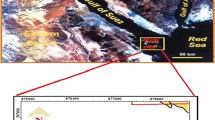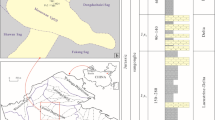Abstract
The Maastrichtian Pab Sandstone and the Danian Khadro Formation are among the major reservoirs of the region but are considered to be tight and are therefore poorly evaluated. A 551-m-thick section of the Pab Sandstone and 128-m-thick section of the Khadro Formation are measured and logged in detail. The measured units mainly composed of thin- to thick-bedded sandstone with subordinate mudstone and occasional marls that were deposited in the western passive margin of the Indian Plate. Eight and four depositional facies have been identified in the Pab and Khadro Formations, respectively, and are grouped into pro-delta, delta-front, and delta-plain facies associations which were deposited in fluvial-wave-dominated deltaic settings. Thirty-two samples of sandstones from Pab Sandstone and 20 from Khadro Formation are collected for reservoir and petrographic studies. The sandstone of studied formations are classified as quartz aernite, subarkosic, sublitharenite, and wackes. These are fine to coarse grain, subangular to rounded, and poorly to moderately sorted. The intense burial diagenesis resulted in compaction, extensive cementation, and authigenic mineralization which cause low values of porosity/permeability. Cements have filled all the available pore spaces and clay minerals block pore throats, thus resulting in major destruction of porosity and permeability. The late stage dissolution of unstable framework grains and cements has resulted in appreciable increase in secondary porosity. The petrographic studies and plug porosity/permeability results of outcrop samples suggest that laterally continuous and vertically stacked thick sandstone sequences of delta-plain and delta-front facies associations possess good values of porosity.
















Similar content being viewed by others
References
Abbas G (1999) Microfacies, depositional environment, diagenesis and porosity development in limestone horizons of Kirthar Formation in frontal part of Sulieman Fold-Thrust Belt and adjoining areas, Pakistan. Unpublished Ph.D thesis, University of Punjab, Pakistan
Abbas G, Ahmed Z (1979) The Muslim Bagh ophiolites. In: Geodynamics of Pakistan. Geological Survey of Pakistan, Quetta, pp. 243–250
Alleman F (1979) Time of emplacement of the Zhob Valley ophiolites and Bela ophiolites, Baluchistan (preliminary report). In: Farah A, Dejong K, (Eds.), Geodynamics of Pakistan. Geological Survey of Pakistan: 215–221
Allen JRL (1980) Sand waves: a model of origin and internal structure. J Sed Geol 26:281–328
Antonellini MA, Aydin A, Pollard DD (1994) Microstructure of deformation bands in porous sandstones at Arches National Park, Utah. J Str Geol 16: 941–959
Antonellini M, Aydin A (1995) Effect of faulting on fluid flow in porous sandstones: geometry and spatial distribution. AAPG 79:642–671
Aydin A, Johnson AM (1983) Analysis of faulting in porous sandstones. J Str Geol 5:19–31
Banks CJ, Warburton J (1986) Passive-roof duplex geometry in the frontal structures of the Kirthar and Sulaiman Mountain Belts, Pakistan. J Struc Geol 8:229–237
Basilici G (2002) From sand to sand-mud deep-water ramp: the Api˙na unit (Early Cambrian, South Brazil). AAPG Search and Discovery Article, AAPG Annual Meeting, Houston, Texas, 90007
Besse J, Courtillet V (1988) Palaeogeographic maps of the continents bordering the Indian Ocean since the Early Jurassic. J Geop Res 92:11791–11808
Blatt H (1979) Diagenetic processes in sandstones. In: Aspects of diagenesis (Ed. scholle PA, schluger PR) spec soc econ paleont miner. Tulsa 26:141–158
Brenchley PJ, Newell G, Stanistreet IG (1979) A storm surge origin for sandstone beds in an epicontinental platform sequence, Ordovician Norway. Sediment Geol 22:185–217
Carrigy MA, Mellon GB (1964) Authigenic clay mineral cements in Cretaceous and Tertiary sandstones of Alberta. J Sed Pet 34:461–472
Curtis CD (1983) Geochemistry of porosity enhancement and reduction on clastic sediments. In: Brooks J (ed) Petro geochem and expl of Europe, vol 12. Special Publication of Geol Soc, Blackwell Scientific Publications, Oxford, pp. 113–125
Dolan P (1990) Pakistan: A history of petroleum exploration and future potential. In Brooks, J. (Eds.), Classic petroleum provinces. Geol Soc Lond Spec Pub 50: 503–524
Dott RH Jr, Bourgeois J (1982) Hummocky cross stratification: significance of its variable bedding sequences. Geol Soc Am Bull 64:43–63
Ehrenberg SN (1990) Relationship between diagenesis and reservoir quality in sandstones of the Garn Formation, Haltenbanken, mid-Norwegian continental shelf. AAPG Bull 74:1538–1558
Ehrenberg SN (1995) Measuring sandstone compaction from modal analyses of thin sections: how to do it and what the result mean. J Sed Res A 65:369–379
Eschard R, Albouy E, Gaumet F, Ayub A (2002) Comparing basin floor fan versus slope fan depositional architecture in the Pab sandstone, Maastrichtian, Pakistan. In: S.A. Lomas & P. Joseph (Eds.), Geological Society Special Publications 222
Eschard R, Albouy E, et al. (2003) Downstream evolution and turbiditic channel complexes in the Pab Range outcrops (Maastrichtian, Pakistan). Mar Petro Geol 20:691–710
Eschard R, Albouy E, et al. (2004) Comparing the depositional architecture of basin floor fans and slope fans in the Pab sandstone, Maastrichtian Pakistan. Geol Soc Lond Spe Pub 222:159–185
Farah A, Lawrence RD, et al. (1984) An overview of the tectonics of Pakistan. In: Haq BU, Milliman JD (eds) Marine geology and oceanography of the Arabian Sea and coastal Pakistan. Van Nostrand Reinhold, New York, pp. 161–176
Fitzsimmons R, Buchanan J, Izatt C (2005) The role of outcrop geology in predicting reservoir presence in the Cretaceous and Paleocene successions of the Sulaiman Range, Pakistan. AAPG Bull 89(2):231–254
Fossen H, Hesthammer J (1998) Deformation bands and their significance in porous sandstone reservoirs. First Break 16:21–25
Gansser A (1979) Reconnaissance visit to the ophiolites in Baluchistan and the Himalayas. In: Farah A, Dejong KA (eds) Geodynamics of Pakistan. GSP, Quetta, pp. 193–214
Gnos E, Immenhauser A, Peters TJ (1997) Late Cretaceous/Early Tertiary convergence between the Indians and Arabian plates recorded in ophiolites and related sediments. Tectonophysics 271:1–19
Harris NB (1989) Diagenetic quartzarenite and destruction of secondary porosity: an example from the middle Jurassic Brent sandstone of northwest Europe. Geol 17:361–364
Harms JC, Southard JB, Spearing DR, Walker RG (1975) Depositional environments as interpreted from primary sedimentary structures and stratification sequences. SEPM Short Course 2:161
Hayes JB (1979) Sandstone diagenesis: the whole truth. In: Scholle PA, Schluger PR (eds.), SEPM Spec Pub 26: 127–139
Hedley R, Warburton J, Smewing J (2001) Sequence stratigraphy and tectonics in the Kirthar Fold Belt, Pakistan. In: proceedings of the SPE-PAPG Annual Technical Conference, Islamabad: 61–72
Hemphill WR, Kidwai AH (1973) Stratigraphy of the Bannu and Dera Ismail Khan areas, Pakistan. USGS Prof Paper 716b: 36
Houseknecht DW (1987) Assessing the relative importance of compaction processes and cementation to reduction of porosity in sandstones. AAPG Bull 71:633–642
Hunting Survey Corporation (HSC) (1960) Reconnaissance geology of part of West Pakistan. Colombo Plan Cooperative Project, Toronto, Maracle Press, 555
Hurst AR (1987) Problems of reservoir characterization in some North Sea sandstone reservoirs solved by the application of micro scale geological data. In: Kleppe J, Berg EW, Buller AT, Hjelmeland O, Torsaeter O (eds) North Sea Oil And Gas reservoirs. Norwegian Petroleum Directorate, Graham and Trotman, London, pp. 153–167
Humayon M, Lille RJ, et al. (1991) Structural interpretation of the eastern Sulaiman fold belt and foredeep, Pakistan. Tectonic 10(2):299–324
Jones AG (1961) Reconnaissance geology of part of West Pakistan (Ed.), A Colombo Plan Cooperative Project, Hunting Survey Corporation, Maracle Press, Toronto, 550
Kazmi AH, Rana RA (1982) Tectonic map of Pakistan, scale, 1:2,000,000. GSP, Quetta
Kazmi AH, Abbasi AI (2008) Stratigraphy and historical geology of Pakistan. National Center of Excellence in Geology, Peshawar Publication, Peshawar, pp. 181–185
Khan AS, Kelling G, Umar M, Kassi AM (2002) Depositional environments and reservoir assessment of Late Cretaceous sandstones in the south Central Kirthar Fold Belt, Pakistan. J Petr Geol 259(4):373–406
Lawrence RD, Yeats RS (1979) Geological reconnaissance of Chaman Fault in Pakistan. In: Farah A, DeJong KA (eds) Geodynamics of Pakistan. GSP, Quetta, pp. 351–357
Lundegard PD (1992) Sandstone porosity loss a “big picture” view of the importance of compaction. J Sed Pet 62:250–260
Lyell SC (1865) Elements of geology, 6th edn. John Murray, London
McBride EF, Diggs TN, Wilson JC (1991) Compaction of Wilcox and Carrizo Sandstones (Paleocene-Eocene) to 4420 M, Texas Gulf Coast. J Sed Pet 61:73–85
Moghal MA, Saqi MI, Jamij MA (2012) Hydrocarbon potential of tight sand reservoir (Pab Sandstone) in Central Indus Basin-Pakistan. Search and Discovery Article 50608, AAPG
Nilsen TH (1984) Turbidites facies associations. In: Nelson, C. H., Nilsen, T.H. (Ed.), Modern and ancient deep-sea fan sedimentation. SEPM Short Course 14: 301–325
Ogilvie SR, Glover PWJ (2001) The petrophysical properties of deformation bands in relation to their microstructure. Ear and Plan Scie Let 193:129–142
Pettijohn F, Portter P, Siever (1972) Sand and sandstone. Springer, New York, NY, USA
Pickering KT (1983) Transitional submarine fan deposits from the Late Precambrian Kongsfjord formations submarine fan, NE Finnmark, North Norway. Sedimentology 30:181–199
Rossel NC (1982) Clay mineral diagenesis in Rotliegend aeolian sandstones of the southern North Sea. Clay Miner 17:69–77
Scotese CR, Cahagan LM, Larson RL (1988) Plate tectonic reconstructions of the Cretaceous and Cenozoic basins. Tectonophysics 155:27–48
Seemann U (1982) Depositional facies, diagenetic clay minerals and reservoir quality of Rotliegend sediments in the Southern Permian Basin (North Sea): a review. Clay Miner 17:55–67
Smewing JD, Seago RD (1995) Geological field survey of Sulaiman block and adjacent areas, northeast Baluchistan, Pakistan. Earth Resources Institute, report number EP 95-1, 1–3, 176
Smewing JD, Warburton J, Daley T, Copestake P, Haq N (2002) Sequence stratigraphy of the Southern Kirtharfold Belt and middle Indus Basin, Pakistan. In: Clift PD, Kroon D, Gaedicke C, Craig J (eds) The tectonic and climatic evolution of the Arabian Sea region, Geol Soc (London) Spec Pub, vol 195, pp. 273–299
Sultan M, Gipson MJ (1995) Reservoir potential of the Maastrichtian Pab sandstone in the Eastern Sulaiman fold belt. J Petro Geol 18:309–328
Surdam RC, Boese SW, Crossey LJ (1984) The chemistry of secondary porosity. In: Surdam, R.C. (Ed.), Clastic diagenesis. AAPG Mem 37: 127–150
Swift DJP, Figuerido AG, Freeland GL, Oertel GF (1983) Hummocky cross stratification and megaripples: a geological double standard? J Sediment Petrol 53:1295–1317
Tainsh HR, Stringer KV, Azad J (1959) Major gas fields of West Pakistan. AAPG Bull 43:2675–2700
Taylor TR, Soule CH (1993) Reservoir characterization and diagenesis of the Oligocene 64-Zone sandstone, North Belridge Field, Kern County, California. AAPG Bull 77:1549–1566
Terry RD, Chilingar GV (1955) Summary of “concerning some additional aids in studying sedimentary formations” In: Shvetsov MS (Ed.), J Sed Pet 25: 229–234
Treloar PJ, Izatt CN (1993) Tectonics of the Himalayan collision between the Indian plate and the Afghan block. In Treloar, P.J., Searle, M.P. (Eds.), Himalayan tectonics. Geol Soc (Lond) Spec Pub 74: 69–87
Tucker EM (2003) Mixed clastic-carbonate cycles and sequences: quaternary of Egypt and carboniferous of England. Geologia Croatica 56:19–37
Vavra CL (1983) Mineral reactions and control on zeolite facies alteration in sandstone in Central Transantaractic Mountains, antaractica (abs). AAPG Bull 67:563
Waheed A, Wells NA (1990) Changes in palaeo currents during development of an obliquely convergent boundary (Sulaiman fold belt, southwestern Himalayas, west central, Pakistan). Sed Geol 67:237–261
Wells NA (1984) Marine and continental sedimentation in the Early Cenozoic Kohat Basin and adjacent northwestern Pakistan, Ph.D. dissertation, University of Michigan, Ann Arbor, 465
Wilson MD, Pittman ED (1977) Authigenic clays in sandstones: recognition and influence on reservoir properties and paleo environmental analysis. J Sed Pet 47:3–31
Wilson JC, McBride EF (1988) Compaction and porosity evolution of Pliocene Sandstones, Ventura Basin, California. AAPG 72:664–681
Acknowledgments
The field work of this research was funded by the Department of Geology, University of Peshawar. Higher Education Commission, Pakistan, provided the funding for different laboratory analyses. Dr. Suleman Khan and Mohammad Raiz from University of Peshawar reviewed the manuscript before submission.
Author information
Authors and Affiliations
Corresponding author
Rights and permissions
About this article
Cite this article
Khan, I., Ahmad, S., Arif, M. et al. Impact of diagenetic and depositional fabric on reservoir quality; a synthesis from Late Cretaceous and Early Paleocene sandstones in Eastern Sulaiman Range, Pakistan. Arab J Geosci 9, 388 (2016). https://doi.org/10.1007/s12517-016-2372-3
Received:
Accepted:
Published:
DOI: https://doi.org/10.1007/s12517-016-2372-3




